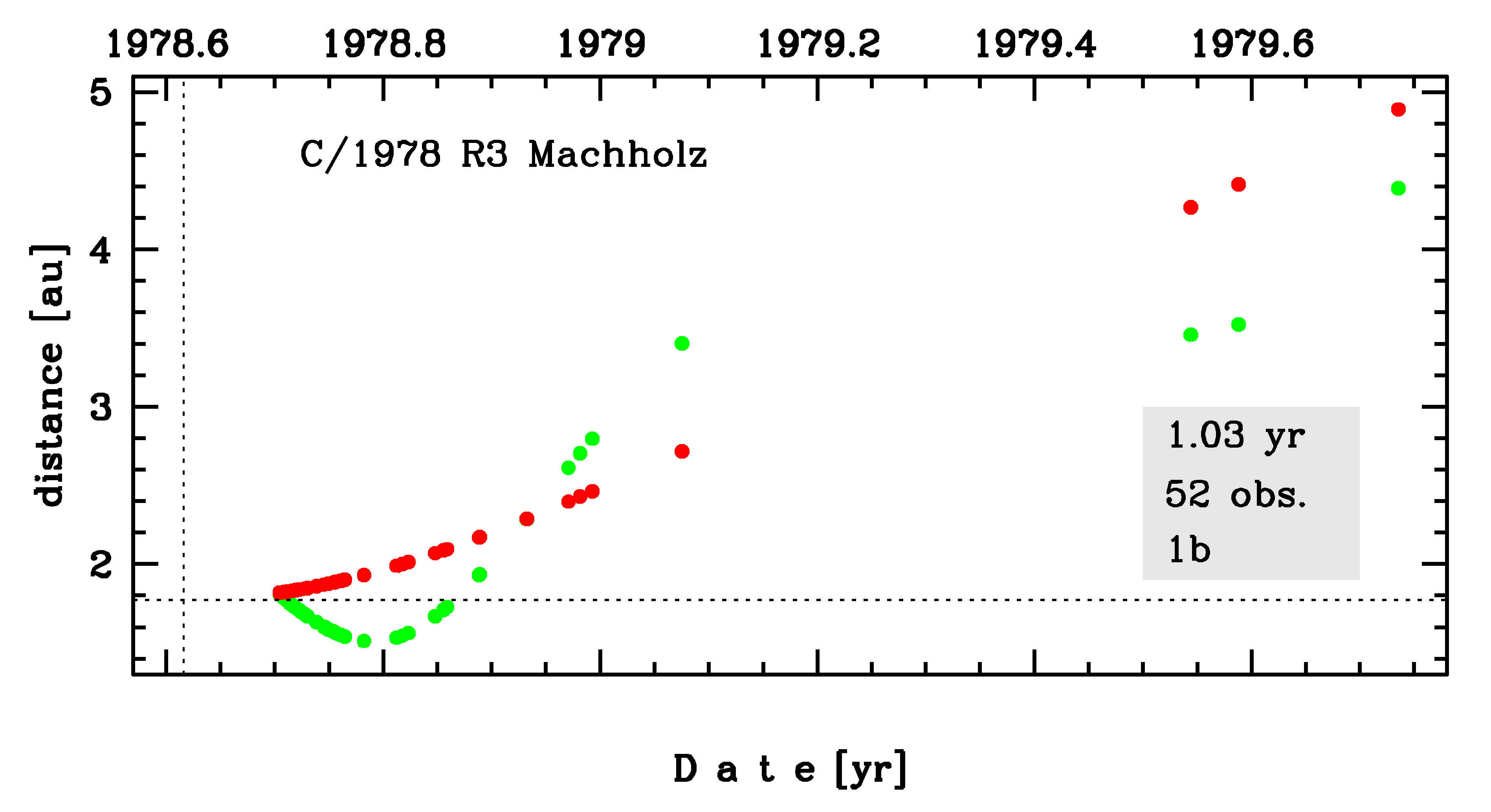C/1978 R3 Machholz
more info
Comet C/1978 R3 was discovered on 12 September 1978 by Donald E. Machholz (Mt Loma Prita, California, USA), that is about a month after its perihelion passage.This comet was last observed on late September 1979.
Comet had its closest approach to the Earth on 15 October 1978 (1.510 au), about a month after discovery.
Solution given here is based on data spanning over 1.03 yr in a range of heliocentric distances from 1.82 au to 4.89 au.
This Oort spike comet suffers small planetary perturbations during its passage through the planetary system; these perturbations lead to a more tight future orbit.See also Królikowska 2020.
Comet had its closest approach to the Earth on 15 October 1978 (1.510 au), about a month after discovery.
Solution given here is based on data spanning over 1.03 yr in a range of heliocentric distances from 1.82 au to 4.89 au.
This Oort spike comet suffers small planetary perturbations during its passage through the planetary system; these perturbations lead to a more tight future orbit.See also Królikowska 2020.
| solution description | ||
|---|---|---|
| number of observations | 52 | |
| data interval | 1978 09 14 – 1979 09 25 | |
| data type | observed only after perihelion (POST) | |
| data arc selection | entire data set (STD) | |
| range of heliocentric distances | 1.82 au – 4.89au | |
| detectability of NG effects in the comet's motion | NG effects not determinable | |
| type of model of motion | GR - gravitational orbit | |
| data weighting | NO | |
| number of residuals | 101 | |
| RMS [arcseconds] | 1.50 | |
| orbit quality class | 1b | |
| previous orbit statistics, both Galactic and stellar perturbations were taken into account | ||
|---|---|---|
| no. of returning VCs in the swarm | 4828 | * |
| no. of escaping VCs in the swarm | 173 | |
| no. of hyperbolas among escaping VCs in the swarm | 28 | |
| previous reciprocal semi-major axis [10-6 au-1] | 39.64 – 71.76 – 106.86 | R |
| previous perihelion distance [au] | 1.9 – 2.8 – 290 | R |
| previous aphelion distance [103 au] | 19 – 28 – 50 | R |
| time interval to previous perihelion [Myr] | 0.9 – 1.6 – 4.3 | R |
| percentage of VCs with qprev < 10 | 76 | |
| percentage of VCs with 10 < qprev < 20 | 1 | |
| percentage of VCs with qprev > 20 | 23 | |
| previous_g orbit statistics, here only the Galactic tide has been included | ||
|---|---|---|
| no. of returning VCs in the swarm | 4868 | * |
| no. of escaping VCs in the swarm | 133 | |
| no. of hyperbolas among escaping VCs in the swarm | 29 | |
| previous reciprocal semi-major axis [10-6 au-1] | 37.96 – 71.47 – 106.66 | R |
| previous perihelion distance [au] | 1.9 – 2.4 – 12 | R |
| previous aphelion distance [103 au] | 19 – 28 – 53 | R |
| time interval to previous perihelion [Myr] | 0.91 – 1.7 – 4.3 | R |
| percentage of VCs with qprev < 10 | 89 | |
| percentage of VCs with 10 < qprev < 20 | 4 | |
| percentage of VCs with qprev > 20 | 7 | |
